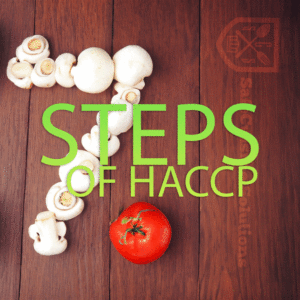
Hazard Analysis and Critical Control Points (HACCP) is a systematic approach to food safety management that helps identify, evaluate, and control potential hazards in food production processes. HACCP provides a comprehensive framework for ensuring the safety and integrity of food from farm to fork. In this blog post, we will delve into the world of HACCP, exploring its principles, benefits, and steps involved, empowering you to implement this robust system in your food establishment.
Understanding HACCP:
-
Principles of HACCP: HACCP is based on seven core principles that serve as the foundation for effective food safety management:
- Conduct hazard analysis
- Determine critical control points (CCPs)
- Establish critical limits
- Monitor CCPs
- Establish corrective actions
- Verify effectiveness
- Document and maintain records
-
Benefits of HACCP: Implementing HACCP brings numerous benefits to food establishments:
- Enhances food safety by focusing on critical control points
- Identifies potential hazards and enables proactive prevention measures
- Improves quality control, reducing the risk of contamination and foodborne illnesses
- Helps establishments comply with food safety regulations and standards
- Enhances customer trust and confidence in the safety of food products
- Optimizes operational efficiency and reduces costs associated with product recalls and wastage
Steps Involved in HACCP Implementation:
- Assemble the HACCP Team: Form a multidisciplinary team consisting of individuals with expertise in food safety, production processes, quality control, and relevant areas. This team will be responsible for developing and implementing the HACCP plan.
- Conduct a Hazard Analysis: Identify and assess potential hazards at each step of the food production process. This analysis includes biological, chemical, and physical hazards that may pose risks to food safety. Thoroughly evaluate all possible hazards and their associated risks.
- Determine Critical Control Points (CCPs): Determine the critical control points in the production process where hazards can be prevented, eliminated, or reduced to an acceptable level. These points are crucial for maintaining food safety, and specific control measures are applied at these stages.
- Establish Critical Limits: Set critical limits for each identified CCP, defining the acceptable boundaries within which hazards can be controlled. These limits are measurable and provide clear guidelines for monitoring and verifying control measures.
- Monitor CCPs and Implement Corrective Actions: Continuously monitor the identified CCPs to ensure they are within the established critical limits. If deviations occur, take immediate corrective actions to bring the process back under control and prevent potential hazards.
- Verify Effectiveness: Regularly verify the effectiveness of the implemented HACCP system through methods such as testing, inspections, and internal audits. Ensure that the system is functioning as intended and identify any areas for improvement.
- Document and Maintain Records: Thorough documentation is essential for HACCP implementation. Maintain accurate and detailed records of the HACCP plan, hazard analysis, critical control points, monitoring results, corrective actions, verification activities, and any other relevant information.
HACCP provides a comprehensive and proactive approach to food safety management, enabling food establishments to identify and control potential hazards throughout the production process. By implementing the core principles of HACCP and following the step-by-step process, you can enhance food safety, comply with regulations, and build customer trust.
At SafeCuisine Solutions, we specialize in guiding food establishments through the implementation of HACCP systems tailored to their unique needs. Our team of experts can provide comprehensive consulting services to help you develop and maintain an effective HACCP plan. Together, let’s ensure the highest standards of food safety and create a safe dining experience for all.

